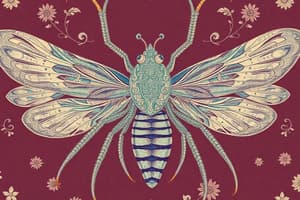Podcast
Questions and Answers
Which of the following are groups of invertebrates? (Select all that apply)
Which of the following are groups of invertebrates? (Select all that apply)
- Mammals
- Echinoderms (correct)
- Sponges (correct)
- Insects
What are the primary characteristics of sponges?
What are the primary characteristics of sponges?
Specialized food cells, reproduce asexually by budding, and sexually.
What are the main features of cnidarians?
What are the main features of cnidarians?
Tentacles, tissues with muscle and nerve cells, reproduce sexually and asexually.
How are worms categorized?
How are worms categorized?
What are mollusks characterized by?
What are mollusks characterized by?
What features are characteristic of echinoderms?
What features are characteristic of echinoderms?
What defines arthropods?
What defines arthropods?
What types of symmetry exist in animals? (Select all that apply)
What types of symmetry exist in animals? (Select all that apply)
What are the main differences between insect groups?
What are the main differences between insect groups?
What are the characteristics of annelids?
What are the characteristics of annelids?
Flashcards are hidden until you start studying
Study Notes
Six Invertebrate Groups
- Major groups include sponges, cnidarians, worms, mollusks, echinoderms, and arthropods.
Sponges
- Characterized by specialized food cells
- Reproduce both asexually through budding and sexually.
Cnidarians
- Possess tentacles with specialized tissues that have muscle and nerve cells
- Can reproduce sexually and asexually.
Worms
- Flatworms represent the simplest group of worms
- Roundworms are more complex compared to flatworms
- Annelids have a segmented structure and possess developed digestive, circulatory, muscular, and nervous systems.
Mollusks
- Typically have a hard outer shell
- Feature well-developed organ systems
- Possess a muscular foot and a mantle.
Echinoderms
- Exhibit radial symmetry and have mouths located at their center
- Possess external spines and internal skeletons
- Feature a water vascular system and tube feet for locomotion.
Arthropods
- Characterized by a segmented body and an outer covering made of chitin
- Possess an exoskeleton and complex body systems.
Types of Symmetry
- Radial symmetry: body parts arranged around a central axis
- Bilateral symmetry: body can be divided into mirror-image halves
- Asymmetrical: lack of symmetry.
Arthropod Groups: Similarities and Differences
- Insects: Three segments, six legs, specialized mouthparts, wings; adaptations for blending into the environment; undergo simple or complete metamorphosis.
- Crustaceans: Have complex body systems and a circulatory system.
- Arachnids: Two body segments and the ability to spin webs of silk.
- Millipedes: Two pairs of legs per body segment.
- Centipedes: One pair of legs per body segment.
Annelids
- Complex worms equipped with digestive, muscular, circulatory, and nervous systems.
- Capable of asexual and sexual reproduction.
Studying That Suits You
Use AI to generate personalized quizzes and flashcards to suit your learning preferences.




